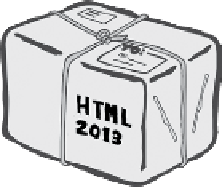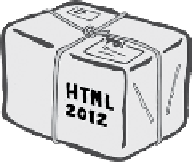HTML and CSS Reference
In-Depth Information
HTML, the new “living standard”
You heard us right…rather than continue to crank out version 6, 7, 8 of HTML, the
standards guys (and gals) have turned the specification into a living standard that will
document the technology as it evolves. So, no more version numbers. And you can stop calling
it HTML5 because it's just “HTML” from here on out.
Now, you're probably wondering how this is going to work in practice. After all, if the spec is
continually changing, what does that mean for the poor browsers? Not to mention, for you,
the web developer? One key to this working is
backwards compatibility
. Backwards compatibility
means that we can keep adding new stuff to HTML, and the browsers will (eventually)
support this new stuff, but they'll also keep supporting the old stuff. So the HTML pages
you're writing today will keep working, even after new features have been added later.
Works on all those…
plus fancy new
browsers we haven't
even thought of yet!
Works on all
those…plus
new versions
of each
Works on:
IE9, Chrome
17, Firefox
10, Safari 5,
Opera 11
Works on all
those…plus
new versions
of each
Notice e
ach new version is ge
tting a little bigge
r because
new stuf
f is being added, bu
t the old stuff stil
l works!
Q:
So what happens if the spec
changes tomorrow? What do I do?
Q:
What exactly is a spec, anyway?
A:
The specification is the document that
specifies what the HTML standard is; that is,
what elements and attributes are in HTML,
and more. This document is maintained by
the World Wide Web Consortium (W3C, for
short), but anyone can contribute to it and
have a say in how the standard is developed.
If the spec changes something you're
already doing, like the way an element or
attribute works, then browsers are supposed
to continue to support the old way you're
using it as well as the new way. That's what
“backwards compatibility” means. Now, it is
obviously a good thing if existing features
are changed as little as possible, and if you,
as a web developer, keep up-to-date on the
spec and change your pages as the spec
changes, but the idea is that your HTML will
continue to work as the spec changes.
A:
If you're writing solid HTML today and
the spec changes tomorrow to incorporate
a new element, then you can just keep
on doing what you're doing. It's up to you
whether you want to use that new element
or not.
















